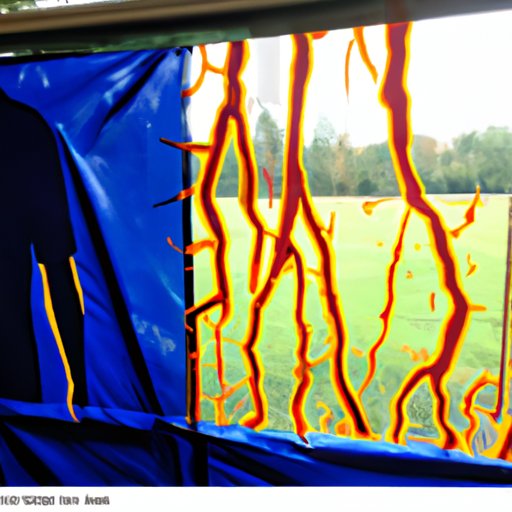Introduction
Tourette Syndrome (TS) is a neurological disorder that affects approximately one percent of school-aged children, according to the Centers for Disease Control and Prevention. It is characterized by involuntary vocalizations and movements, known as tics, which can range from mild to severe. Despite its prevalence, there is still a lack of understanding and awareness about Tourette Syndrome. This article seeks to provide an overview of the condition and explore how it works, including the causes, symptoms, diagnosis and treatment options.
Section 1: Exploring the Causes and Symptoms of Tourette Syndrome
In order to fully understand Tourette Syndrome, it is important to define the condition and identify the associated symptoms. TS is a type of tic disorder, which is defined by the American Psychiatric Association (APA) as “a condition in which an individual makes repetitive, sudden, brief movements or sounds that are not voluntary or purposeful.” These tics can be either simple or complex, and may involve movements such as eye blinking or complex behaviors such as repeating words or phrases.
While the exact cause of Tourette Syndrome is unknown, there are several potential factors that may contribute to its development. According to the National Institute of Neurological Disorders and Stroke, genetic factors play a role in the onset of the disorder, as it is more likely to occur in those with a family history of TS. Additionally, environmental factors such as stress, anxiety, fatigue, and certain medications may trigger tics.

Section 2: A Comprehensive Guide to Diagnosis and Treatment for Tourette Syndrome
If you suspect you or your child may have Tourette Syndrome, it is important to seek medical help for an accurate diagnosis. A doctor will typically ask questions about the frequency, duration, and severity of the tics to determine whether they meet the criteria for TS. In addition, they may refer you to a specialist for further evaluation, such as a neuropsychologist or neurologist.
Once diagnosed, there are several treatment options available to help manage the symptoms of Tourette Syndrome. Medications, such as antipsychotics and antidepressants, can help reduce the frequency and intensity of tics, while behavioral therapies can teach individuals to recognize triggers and learn relaxation techniques to help control their tics. Additionally, cognitive behavioral therapy can help those with Tourette Syndrome develop coping strategies and improve their quality of life.

Section 3: Understanding the Neurological Process Behind Tourette Syndrome
In order to better understand Tourette Syndrome, it is important to explore the neurological process behind the condition. Research has shown that TS is related to imbalances in brain chemistry, specifically dopamine and serotonin. According to a study published in the journal Neuropsychopharmacology, “abnormalities in these neurotransmitter systems underlie the pathophysiology of TS.”
The brain regions most commonly associated with Tourette Syndrome are the basal ganglia and the prefrontal cortex. The basal ganglia is responsible for motor control and is thought to be involved in the generation of tics. The prefrontal cortex is responsible for regulating emotions and behavior, and is thought to be involved in the suppression of tics. Together, these two areas of the brain are believed to be key components in the neurological process of Tourette Syndrome.

Section 4: Analyzing the Effects of Tourette Syndrome on Daily Life
Living with Tourette Syndrome can be challenging, as individuals may face both physical and psychological difficulties. Physical challenges include pain due to muscle tension, as well as difficulty sleeping due to the presence of tics. Psychological challenges include low self-esteem, social isolation, and difficulty concentrating due to the distraction of tics.
Additionally, individuals with Tourette Syndrome may experience discrimination and stigma due to the public’s lack of understanding about the disorder. As Dr. David E. Comings, a noted Tourette Syndrome researcher, states, “It is essential that society become educated about Tourette Syndrome so that those affected with this disorder can live their lives without fear of ridicule or misunderstanding.”
Section 5: Examining the Role of Genetics and Environment Factors in Tourette Syndrome
It is clear that genetics and environment factors both play a role in the development of Tourette Syndrome. Studies have shown that a person’s risk of developing TS increases if they have a family member with the disorder, suggesting a genetic component. Additionally, environmental factors such as stress, anxiety, and fatigue can trigger tics, and certain medications may exacerbate them.
According to a study published in the journal Molecular Psychiatry, “environmental factors are likely to interact with genetic vulnerability to influence the expression and severity of TS.” As such, it is important to consider both genetic and environmental influences when seeking to understand the causes and treatments of Tourette Syndrome.
Section 6: Investigating the Latest Research on Tourette Syndrome
The field of Tourette Syndrome research is constantly evolving, and new treatments and insights are being developed every day. Recent studies have looked into the use of deep brain stimulation, which involves implanting electrodes in the brain to reduce tic frequency, as well as the effectiveness of neurofeedback, which uses feedback loops to help individuals gain greater control over their tics.
Researchers are also exploring the potential benefits of using transcranial magnetic stimulation (TMS), a noninvasive technique that uses magnetic fields to stimulate nerve cells in the brain. While more research is needed, early results suggest that TMS may be effective in reducing tic severity in some individuals.
Conclusion
This article provided an overview of Tourette Syndrome, exploring the causes, symptoms, diagnosis and treatment options available. We examined the neurological process behind the disorder, as well as the effects of genetics and environment factors. Finally, we investigated the latest research on Tourette Syndrome and the potential benefits of new treatments. If you or someone you know is living with TS, it is important to remember that there are many resources available to help manage the condition. For more information, please visit the Tourette Association of America website.
(Note: Is this article not meeting your expectations? Do you have knowledge or insights to share? Unlock new opportunities and expand your reach by joining our authors team. Click Registration to join us and share your expertise with our readers.)
